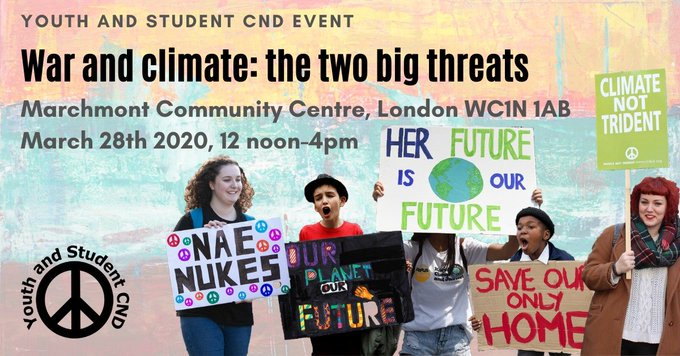NUCLEAR War and climate CATASTROPHE: the two big threats

In the aftermath of the Second World War, a group of scientists who had participated in the Manhattan Project, which produced the world’s first nuclear weapons, set up the Doomsday Clock to determine how close humanity was to a catastrophe caused by human activity. In January of this year, the clock was put at 100 seconds to midnight, the closest it has been since its foundation. The reason given by the scientists, as to why they see humankind teetering on the edge of disaster, is the dual threats of climate change and nuclear war.
Young people have mobilised on a massive scale in response to the threat of climate change over the past couple of years, led by the school climate strikers, Greta Thunberg and Extinction Rebellion. The fact that young people are willing to organise across borders at record levels to ensure a future free from the existential threat of climate catastrophe is a hugely inspiring and positive development; but it needs to be complimented by a revival in youth activism against the other existential threat of nuclear war.
These two issues cannot be divorced from one another. Every pound of the £205 billion that the UK government spends on a new nuclear weapons system could have instead been spent investing in renewable energy sources or green technologies, areas often starved of investment by governments across the globe. The failure to tackle climate change also costs governments a huge amount in damage caused by extreme weather phenomenon. For example, the floods devastating communities in England and Wales, the bushfires in Australia or the sinking of Indonesian homes into the sea.
Climate change also increases the likelihood of war, as resources such as land, clean water and food become increasingly scarce, whilst more of the earth becomes uninhabitable and populations are forced to migrate. Under these pressures states may lose control and non-state actors such as terrorist groups could gain control of nuclear weapons. Any use of nuclear weapons would reap ecological devastation on not only local ecosystems but globally too, as well as hugely damaging the ozone layer – affecting the life which depends on it. This would be in addition to the millions of lives which would be lost in a global nuclear war, both in the immediate blast and in the years after.
This means the solution to climate change must involve global nuclear disarmament. Not only would this free up a massive amount of resources which could then be used in the fight against climate change, it would also help to ensure a future for young people and our planet free from nuclear war.
To achieve this we need a mass mobilisation of young people tying the two issues together and ensuring we have our voices heard. Youth and Student CND will be holding a meeting in London to start planning the fight back against these two existential threats to our futures and we want to hear from as diverse a range of voices as possible. Join us on March 28th!
We’ll be discussing campaigning tactics for the years ahead, building links with other organisations and deciding how best to mobilise our generation.
We’ll also be electing a new committee, if you’re someone who feels passionate about the cause of nuclear disarmament please consider applying. For information on each of the posts available please click here https://cnduk.org/yscndcommittee/.
The Eventbrite registration link for the event is here: https://www.eventbrite.co.uk/e/war-and-climate-the-two-big-threats-tickets-91613910673
The Facebook event can be found here: https://www.facebook.com/events/180723109810012/
